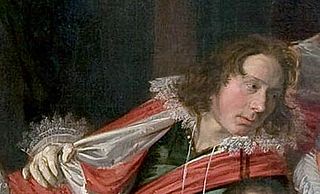Schouten is a surname of Dutch origin. It generally has an occupational root, where the forebear was a schout, but can also be patronymic, as Schoute once was used as a given name. The name is quite common in the Netherlands, ranking 37th in 2007. Variations include Schout, Schoute, Schoutens, Scholten and Scholte. People with this surname include:

Cornelis Corneliszoon van Haarlem, Dutch Golden Age painter and draughtsman, was one of the leading Northern Mannerist artists in the Netherlands, and an important forerunner of Frans Hals as a portraitist.

The Banquet of the Officers of the St George Militia Company in 1616 refers to the first of several large schutterstukken painted by Frans Hals for the St. George civic guard of Haarlem, and today is considered one of the main attractions of the Frans Hals Museum there.

Jacob Pietersz Olycan, was a brewer, magistrate, and later mayor of Haarlem, best known today for his portrait by Frans Hals, pendant to the portrait of Aletta Hannemans, whom he married in Zwolle in 1624.

The Officers of the St Adrian Militia Company in 1630 refers to the schutterstuk painted by Hendrik Gerritsz Pot for the Cluveniers, St. Adrian, or St. Hadrian civic guard of Haarlem, and today is considered one of the main attractions of the Frans Hals Museum there.

Nicolaes Woutersz van der Meer was a Dutch brewer, magistrate and mayor of Haarlem, best known today for his portrait with its pendant of his wife Cornelia Claesdr Voogt, both painted by Frans Hals in 1631.

Andries van Hoorn, or van der Horn, was a Dutch mayor of Haarlem, known best today for his portraits by Frans Hals.

Willem Claesz Vooght, was a mayor of Haarlem best known today for the portrait painted of him by the painter Frans Hals.

Aletta Hanemans (1606–1653), was a grain merchant's daughter from Zwolle, the Netherlands, who became the brewer of the Hoeffijser in Haarlem. She is best known today for her marriage portrait by Frans Hals, painted when she married the brewer, magistrate, and later mayor of Haarlem, Jacob Pietersz Olycan in 1624.

Pieter Schout, was a Dutch Golden Age member of the Haarlem schutterij.

Jacob Cornelisz Schout, was a Dutch Golden Age member of the Haarlem schutterij.

Cornelis Jacobsz Schout, was a Dutch Golden Age member of the Haarlem schutterij.

Hugo Matheusz. Steyn, was a Dutch Golden Age notary and member of the Haarlem schutterij.

Pieter Adriaensz. Verbeek, was a Dutch Golden Age mayor of Haarlem.

Johan van Napels, was a Dutch Golden Age mayor of Haarlem.

Jacob Laurensz., was a Dutch Golden Age brewer and magistrate of Haarlem.

Johan Damius, was a Dutch Golden Age member of the Haarlem schutterij.

Loth Schout, was a Dutch Golden Age brewer of Haarlem.

Johan Schatter, was a Dutch Golden Age brewer and mayor of Haarlem.

Thijman, or Tyman Oosdorp, was a Dutch Golden Age brewer and magistrate of Haarlem.























